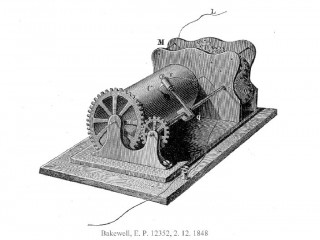
Frederick Bakewell biography
Date of birth : 1800-09-29
Date of death : 1869-09-26
Birthplace : Wakefield, West Yorkshire, England
Nationality : British
Category : Science and Technology
Last modified : 2010-05-19
Credited as : Physicist, ,
0 votes so far
English physicist, Frederick Bakewell developed in 1847 a facsimile system with tin-foil covered revolving drums for transmitting and receiving recorded pictures. Frederick Bakewell, an English physicist, was one of the first to demonstrate facsimile transmission.
Working on a different principle, Frederick Bakewell designed a system that had many of the features of modern facsimile machines. In 1847 he patented a chemical telegraph. Actually, Bakewell improved Bain’s proposal by replacing the pendulums with synchronized rotating cylinders. The first public demonstration of the Bakewell’s facsimile system took place in 1851 at the World’s Fair in London.
Bakewell ’s system involved writing or drawing on a piece of metal foil with a special insulating ink. The foil was then wrapped around a cylinder (C). This cylinder formed a part of a machine, which rotated it slowly on its axis, as in a lathe.
The cylinder rotated at a uniform rate by means of a clock mechanism (M). A metal stylus driven by a screw thread (T) traveled along the surface of the cylinder as it turned, tracing out a path over the complete piece of foil. Each time the stylus crossed a line of the insulating ink, the electrical current running through the foil to the stylus was interrupted. At the receiver, a similar pendulum-driven stylus marked chemically treated paper with an electric current as the receiving cylinder rotated.
The main problems with Bakewell’s machine were how to keep the two cylinders moving at the same rate (in synchronization) and to make sure that both transmitting and receiving styli started at the same point on the cylinder at the same time (in phase). Despite problems with synchronization, Bakewell’s machine was capable of transmitting handwriting and simple line drawings along telegraph wires. It therefore had the potential of allowing, for example, signatures to be verified by different branches of a bank. But Bakewell’s system never became commercial.
Later, in 1861, Bakewell’s system was improved by an Italian priest, Abbe Caselli. Caselli was able to use it to send handwritten messages as well as photographs.
















